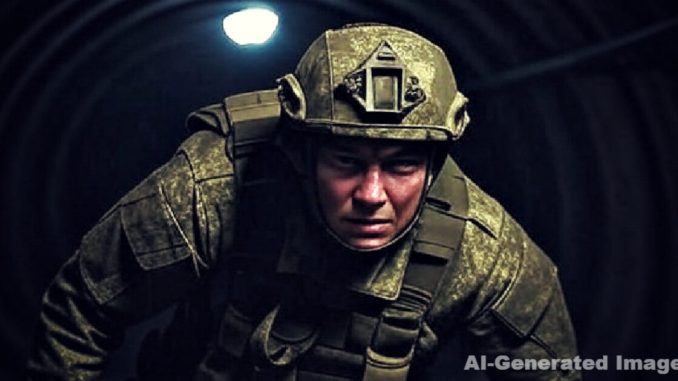
Russian soldier emerging from a gas pipeline near Kupiansk. (Source: DeepState)
Published September 14, 2025
Russian Forces Reportedly Attempt Pipeline Infiltration Toward Kupiansk
Ukrainian sources have reported that Russian troops are attempting to use underground gas pipelines as infiltration routes toward the contested city of Kupiansk in Kharkiv Oblast.
According to accounts, Russian soldiers tried to move through a pipeline north of the city, aiming to reach forested areas that could provide cover for further advances. Ukrainian defenders stated that the pipeline had been damaged, its valves closed, and the area placed under fire control, preventing Russian forces from reaching the city directly.
Other reports, citing social media monitoring groups, describe the use of electric scooters and stretchers inside the pipeline, suggesting attempts to transport troops and supplies over several days. These claims, while dramatic, have not been independently verified.
The tactic mirrors a previous episode during operations in Russia’s Kursk region, where pipelines were reportedly used by troops as covert logistical routes. Ukrainian officials, however, maintain that Kupiansk remains under Ukrainian control and that Russian advances are confined to the outskirts.
The situation underscores Kupiansk’s continued strategic importance. As a key rail hub, control of the city would provide Russia with greater leverage over supply routes in the east, while Ukraine is working to prevent further breakthroughs.
For now, the reports highlight an unusual and risky method of warfare, as both sides adapt to the grinding battles of the Kharkiv front.
 Implications of these reports about Russian forces allegedly using pipelines to infiltrate toward Kupiansk:
Implications of these reports about Russian forces allegedly using pipelines to infiltrate toward Kupiansk:
Military Implications
-
Tactical Adaptation by Russia
-
If true, it shows Russia is experimenting with unconventional infiltration methods to bypass Ukrainian fortifications.
-
Pipelines, sewers, and underground networks could give Russia stealth options, complicating Ukrainian defense planning.
-
-
Ukrainian Countermeasures
-
Ukraine now has to monitor infrastructure as potential battlegrounds, stretching resources to secure not just open terrain but also underground routes.
-
Destroying, blocking, or flooding pipelines becomes part of defense strategy.
-
-
Kupiansk as a Strategic Target
-
The reports confirm Kupiansk is still a high-priority objective for Russia, since it’s a key rail and supply hub in Kharkiv Oblast.
-
If Russia succeeds, it would complicate Ukraine’s logistics and open another route deeper into Ukrainian territory.
-
Psychological / Propaganda Implications
-
Fear Factor
-
Stories of Russians crawling underground with scooters and supplies have shock value — fueling narratives of Russia’s determination and unpredictability.
-
Can unsettle Ukrainian civilians near Kupiansk, creating a sense that Russians can appear “from beneath their feet.”
-
-
Narrative War
-
Pro-Ukraine media (like UNITED24) frame it as a desperate, failing tactic— pipelines cut off, troops trapped.
-
Pro-Russia or critical outlets (like Gateway Pundit) frame it as innovation and persistence, making Russia seem harder to stop.
-
Geopolitical Implications
-
International Perception
-
Western allies may view this as further proof of Russia’s willingness to use unorthodox, risky tactics, reinforcing support for Ukraine’s defense needs.
-
If exaggerated, it could still shape public opinion, making the war appear more chaotic and unconventional.
-
-
Future of Warfare
-
Raises alarms about critical infrastructure as battlegrounds in modern wars — gas lines, water tunnels, subway systems — not just open fronts.
-
Could inspire urban warfare doctrines to consider underground infiltration more seriously.
-
Big Picture
-
For Ukraine: Shows resilience (they reportedly blocked the attempt), but also highlights how stretched they are defending every type of terrain.
-
For Russia: If accurate, it reveals both creativity and desperation — resorting to pipelines may mean conventional assaults aren’t breaking through.
-
For Observers: The truth may be a mix, but the story itself shapes perceptions — which in wartime is almost as important as the battlefield reality.
 Overall Takeaway:
Overall Takeaway:
The reports about Russian troops attempting to use pipelines to infiltrate Kupiansk illustrate both the innovation and desperation driving the war’s next phase. While Ukrainian officials stress that such tactics have been disrupted and are not decisive, the very idea of soldiers moving underground underscores how unconventional and unpredictable this conflict has become.
Whether the pipeline story is fully accurate or partly exaggerated, it reveals three realities:
-
Kupiansk remains a high-stakes target — a rail hub Russia is determined to seize and Ukraine is determined to hold.
-
Critical infrastructure is now a battlefield, forcing defenders to secure not just land and air but also underground networks.
-
The information war is just as fierce as the military one — with one side portraying these moves as desperate and doomed, and the other as clever and unstoppable.
Ultimately, the pipeline infiltration tactic, real or embellished, symbolizes the grinding nature of the conflict: Russia pushing every angle to break through, and Ukraine racing to adapt and counter before those tactics can gain momentum.
SOURCES: THE GATEWAY PUNDIT – GOING DOWN: Ukrainian Sources Confirm That Russian Forces Advancing on Kupyansk Are Using Underground Pipeline to Move Troops and Equipment (VIDEOS)
UNITED 24 MEDIA – Russia Repeats Kursk Tactic: Troops Try to Enter Kupiansk Through Gas Pipeline





Be the first to comment